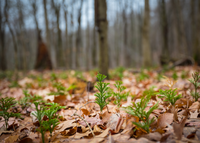Why Are Forest Carbon Models Important?
As they grow, all trees capture carbon from the atmosphere and store it in their trunks, leaves and roots. The more carbon a forest captures and stores, the better it is for the climate. However, not all forests store carbon at the same rate, or in the same quantities. It all depends on where the forest is, its age, how it’s managed and many other factors. Knowing how our actions can build or deplete forest carbon is important, particularly as governments and companies ramp up in investment in forests as a nature-based way to combat climate change.
Forest carbon models are an important way to understand the complexities of forest carbon. These models offer detailed projections of how various actions and events affect a forest’s carbon stores, both in trees and in harvested wood products. For example, these models can be used to compare the outcome of planting different types of trees or the effect of changing how often trees are harvested.
Models can also take into account factors that go beyond forest restoration and management. These include the climate benefits of building with wood compared to carbon-intensive steel and concrete, or the economic impacts of harvesting trees for timber compared to leaving them standing longer for more carbon storage. We can use the results from these models to understand how our management actions impact forest carbon, and to create policies or plans to help us leverage the carbon capturing power of our forests.
Our Carbon Modeling and Research
The current knowledge about forest management as a natural climate solution is limited. So far, researchers have only measured how the frequency of harvesting impacts total forest carbon. However, forest managers use a broad range of actions in their work, and it’s critical to understand how each one of those affects carbon. American Forests is working with seven states — Maryland, Pennsylvania, Minnesota, Michigan, Wisconsin, Oregon and California — to do this.
We are creating detailed models to project how different forest management actions and natural disturbances will affect carbon capture and storage at state and regional levels. Our models consider the broad range of management practices used in each state and account for the ways climate change may impact forest growth in the future. We account for the carbon in the forest itself as well as the carbon still stored in wood products after trees are harvested. This work will help guide each state towards decisions that optimize forest management for carbon sequestration, economics and a range of other benefits. It will also enable the inclusion of forests in state-level climate action planning.




Our Research Partners
American Forests collaborates on this research with the Northern Institute of Applied Climate Science, Michigan State University, the United States Forest Service and the Canadian Forest Service, with support from the U.S. Climate Alliance and state partner agencies.
Our projects also include consultations with staff from each state’s natural resources and forestry agencies. These include the Maryland DNR Forest Service, the Pennsylvania DCNR Bureau of Forestry, the Minnesota DNR Division of Forestry, the Michigan DNR Forest Resources Division, the Wisconsin DNR Division of Forestry, the Oregon Department of Forestry, and the California Department of Forestry and Fire Protection, also known as Cal Fire.




